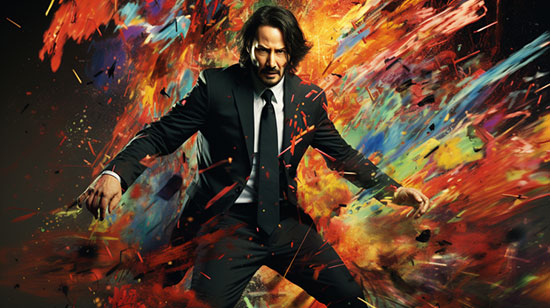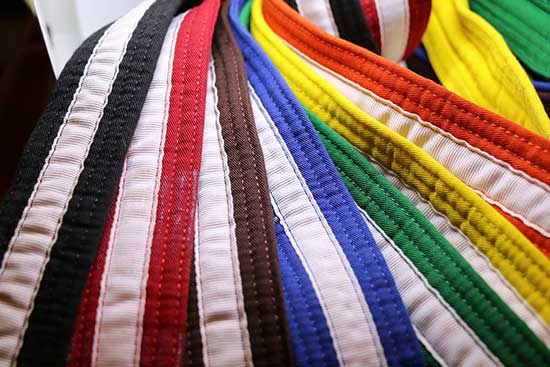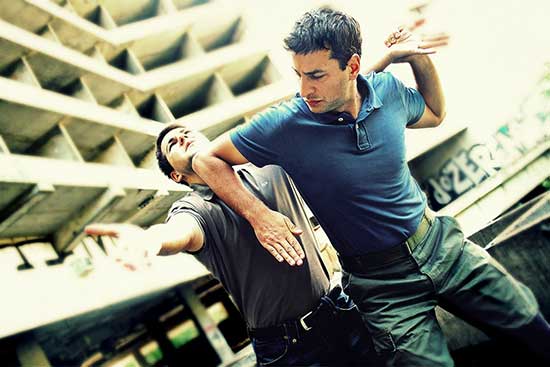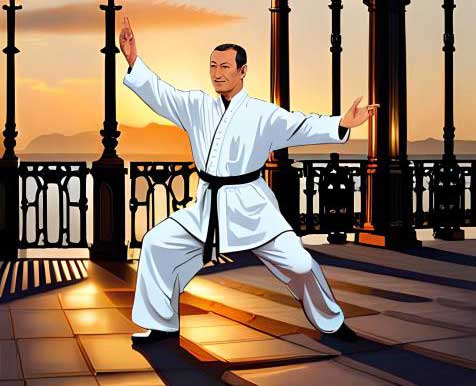The world of martial arts is incredibly diverse, with each discipline having its own unique characteristics and history. In this article, we will compare and analyze two popular fighting styles – Capoeira and Krav Maga.
Capoeira is a Brazilian martial art that combines dance, acrobatics, and music. It originated during the 16th century as African slaves introduced martial arts elements from their native cultures. Capoeira served as a form of self-defense and a way for slaves to express their culture and resist oppression. Today, it is recognized as a Brazilian martial art and cultural practice.
Krav Maga, on the other hand, is an Israeli self-defense system developed by Imi Lichtenfeld. It combines techniques from various martial arts and self-defense systems, with a primary focus on practical self-defense in real-world scenarios. Krav Maga teaches students to neutralize threats quickly and effectively.
Key Takeaways:
- Capoeira is a Brazilian martial art that combines dance, acrobatics, and music.
- Krav Maga is an Israeli self-defense system that prioritizes practical self-defense techniques.
- Capoeira originated as a form of self-defense and cultural expression for African slaves in Brazil.
- Krav Maga focuses on preparing individuals to react quickly and decisively in dangerous situations.
- Both martial arts have their unique advantages and applications depending on personal preferences and goals.
Contents
The Origins and History of Capoeira
Capoeira, a fascinating Brazilian martial art, has a rich history deeply rooted in African slave culture. It dates back to the 16th century when enslaved Africans brought their native combat techniques to Brazil.
Forced to disguise their training, slaves incorporated dance and music into their martial arts practice, creating what is now known as Capoeira. This fusion of self-defense, acrobatics, and cultural expression became a powerful tool for resistance and cultural preservation.
During this time, colonial authorities in Brazil sought to suppress any form of resistance from enslaved Africans. To evade detection, Capoeira was performed as a dance, allowing participants to train their martial arts skills while appearing non-threatening. The true techniques and traditions of Capoeira were carefully hidden within the rhythmic movements and music, ensuring the survival of this unique martial art.
Over time, Capoeira evolved and gained recognition as a Brazilian martial art and cultural practice. Today, it is celebrated worldwide for its combination of dynamic movements, acrobatics, and music. Capoeira not only serves as a physical discipline but also as a means of cultural expression, connecting people to their African roots and promoting inclusivity.
The Evolution of Capoeira
Throughout history, Capoeira has undergone various stages of development. Initially practiced by enslaved Africans, it was a form of self-defense and resistance against oppression.
As Brazil abolished slavery in 1888, Capoeira began to emerge from the shadows, with practitioners openly showcasing their skills and forming organized groups. In the early 20th century, Capoeira underwent further transformation as dedicated masters and academies were established to preserve and disseminate the art form.
Today, Capoeira is practiced by people of all backgrounds, regardless of age, gender, or physical ability. It continues to evolve and adapt, with new movements and techniques being added while honoring its traditional roots. Capoeira remains a testament to the strength and resilience of the African diaspora and serves as a reminder of the cultural contributions made by enslaved Africans in Brazil.
The Principles and Techniques of Capoeira
Capoeira is a unique martial art that encompasses a wide range of principles, techniques, and cultural elements.
One of the distinguishing features of capoeira is its emphasis on fluid, acrobatic movements. Practitioners perform a series of kicks, sweeps, and ground-based techniques with grace and agility.
These acrobatic movements not only make capoeira visually captivating but also serve a practical purpose in combat. By incorporating acrobatics into their fighting style, capoeira practitioners are able to confuse and outmaneuver their opponents.
The unpredictability of the movements makes it difficult for adversaries to anticipate the next attack or defense, giving capoeiristas a strategic advantage.
Another integral aspect of capoeira is its strong connection to music. During training and performances, capoeiristas play traditional instruments such as the berimbau, pandeiro, and atabaque, creating a rhythmic accompaniment to their movements.
The music sets the tempo and energy of the capoeira roda, the circle where capoeiristas practice and showcase their skills. All participants, including those not directly engaged in the physical exchange, contribute by singing songs that reflect the history and traditions of capoeira.
| Capoeira Benefits |
|---|
| Improved flexibility and coordination |
| Enhanced body awareness and control |
| Cardiovascular conditioning |
| Increased agility and balance |
| Cultural enrichment and appreciation |
Overall, capoeira offers a multitude of benefits for those who practice it. The physical demands of capoeira training contribute to improved flexibility, coordination, and cardiovascular fitness. Additionally, the expressive nature of capoeira allows practitioners to develop a sense of body awareness and control. Beyond the physical aspects, capoeira provides cultural enrichment, fostering an appreciation for Brazilian history and traditions.
As we explore the world of capoeira, it is important to recognize and appreciate the rich blend of artistry, athleticism, and cultural heritage that defines this martial art.
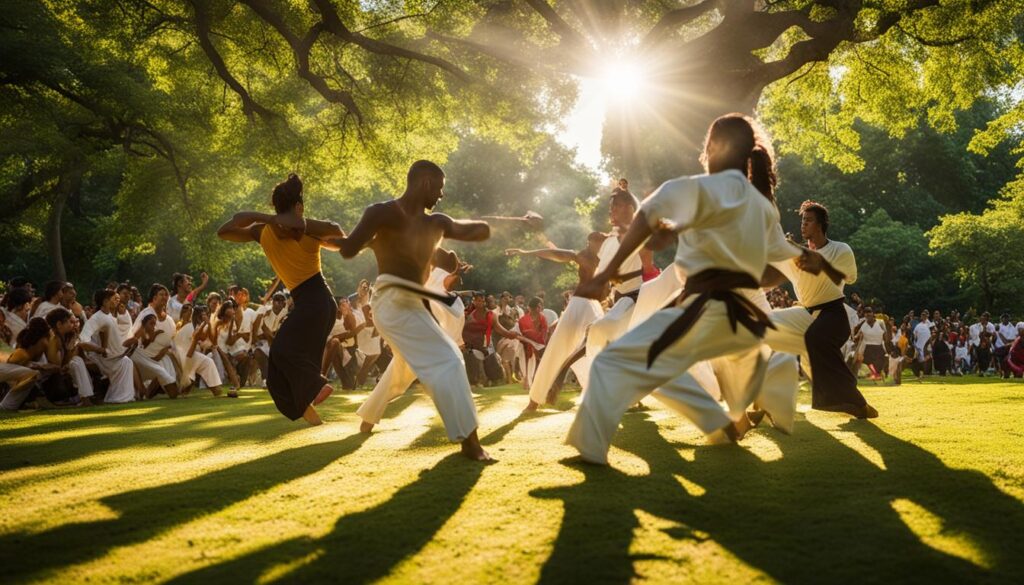
The Philosophy and Approach of Krav Maga
Krav Maga, with its practical self-defense techniques and focus on real-world scenarios, offers numerous advantages for individuals seeking effective self-defense skills. Developed by Imi Lichtenfeld in Israel, Krav Maga draws upon techniques from various martial arts and self-defense systems, making it a versatile and adaptable fighting style.
The philosophy of Krav Maga is rooted in the belief that anyone, regardless of their age or physical abilities, should be able to defend themselves effectively. It emphasizes instinctive reactions and practical techniques that can be easily learned and applied in high-stress situations.
One of the key advantages of Krav Maga is its focus on real-world scenarios. Rather than relying on choreographed moves or rules-based combat, Krav Maga prepares practitioners to defend against common attacks and overcome threats they may encounter in their everyday lives. This practical approach ensures that individuals are equipped with the skills they need to protect themselves and others in the most realistic and effective manner possible.
| Advantages of Krav Maga | Practical Self-Defense | Real-World Scenarios |
|---|---|---|
| Accessible to individuals of all ages and physical abilities | Teaches effective techniques for neutralizing threats quickly | Prepares practitioners to defend against common attacks |
| Focuses on instinctive reactions and practical techniques | Develops confidence and situational awareness | Equips individuals to respond effectively in high-stress situations |
| Adaptable and versatile fighting style | Emphasizes personal safety and the safety of others | Instills a mindset of preparedness and self-reliance |
Techniques and Training in Krav Maga
Krav Maga training encompasses a comprehensive range of techniques and strategies designed for effective self-defense in real-world scenarios. The system emphasizes practicality and efficiency, equipping individuals with the skills needed to neutralize threats quickly and decisively. Here is an overview of the key components of Krav Maga training:
Self-Defense Techniques
In Krav Maga, practitioners learn a wide array of self-defense techniques that encompass strikes, kicks, joint locks, and defensive tactics. These techniques are specifically tailored to address common attacks encountered in real-life situations, such as punches, chokes, and grabs.
The emphasis is on simplicity and effectiveness, enabling individuals of all ages and physical abilities to execute the techniques with maximum efficiency.
Conditioning Drills
Physical conditioning is a vital aspect of Krav Maga training. Conditioning drills are incorporated to enhance strength, speed, agility, and endurance. These drills often involve high-intensity movements and simulated combat scenarios to prepare practitioners for the physical demands and stress of real-life encounters.
By improving overall fitness and stamina, individuals can better withstand physical exertion and maintain focus during critical moments.
Scenario-Based Training
Krav Maga places a strong emphasis on scenario-based training, simulating real-life situations to enhance situational awareness and decision-making skills. Practitioners learn how to react effectively to various threats, including armed assailants, multiple attackers, and common street confrontations.
By training in realistic scenarios, individuals develop the ability to assess and respond to danger with speed, precision, and confidence.
Overall, Krav Maga provides a comprehensive system of training that equips individuals with practical self-defense skills. The techniques, conditioning drills, and scenario-based training are designed to develop physical readiness, mental resilience, and the ability to adapt to unpredictable situations. By combining effective techniques with strategic training methods, Krav Maga prepares individuals to protect themselves and others in challenging and potentially dangerous situations.
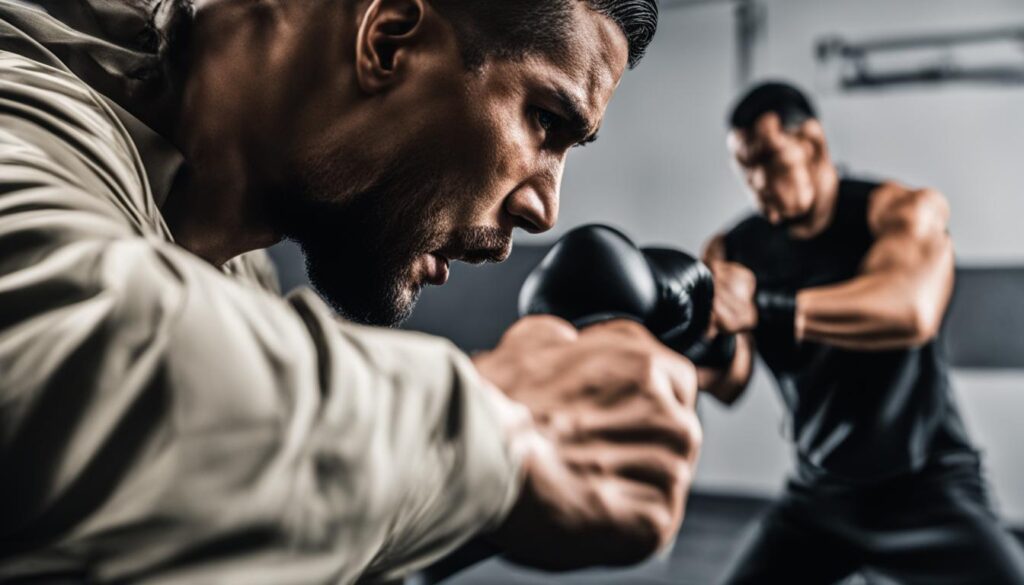
Comparing Capoeira and Krav Maga
Capoeira and Krav Maga are two distinct martial arts with contrasting styles and philosophies. While both disciplines focus on self-defense, they differ in their approach, techniques, and cultural significance.
Styles and Techniques
Capoeira is known for its fluid, acrobatic movements that combine dance and martial arts. Participants engage in intricate kicks, sweeps, and ground-based techniques, all accompanied by music and singing. Capoeira emphasizes improvisation and unpredictability, making it a dynamic and creative fighting style.
Krav Maga, on the other hand, is a practical self-defense system developed for real-world scenarios. It prioritizes effectiveness and efficiency, teaching students to neutralize threats quickly. Krav Maga techniques focus on strikes, kicks, joint locks, and defensive tactics against various attacks, aiming to empower individuals with practical skills for self-protection.
Philosophies and Approaches
The philosophies behind Capoeira and Krav Maga also differ significantly. Capoeira is deeply rooted in Brazilian culture and history, honoring its African slave origins and serving as a form of resistance against oppression. It embodies grace, rhythm, and cultural expression, fostering a sense of community and cultural preservation.
Krav Maga, on the other hand, was developed in Israel as a means of self-defense for military and law enforcement personnel. Its philosophy is grounded in practicality, simplicity, and adaptability. The focus is on survival and neutralizing threats efficiently, regardless of the individual’s physical abilities.
| Capoeira | Krav Maga |
|---|---|
| Fluid, acrobatic movements | Practical and efficient techniques |
| Emphasis on improvisation and unpredictability | Focus on real-world scenarios and quick neutralization of threats |
| Cultural expression and community | Pragmatic philosophy and adaptability |
Overall, Capoeira and Krav Maga offer distinct approaches to self-defense and martial arts. Capoeira showcases a rich cultural heritage and artistic expression, while Krav Maga provides practical, effective techniques for real-life situations. The choice between the two depends on individual preferences, goals, and the desired focus of training.
Advantages and Applications of Capoeira and Krav Maga
Both Capoeira and Krav Maga offer unique advantages and applications within the realm of martial arts. Capoeira, with its combination of dance, acrobatics, and music, provides a range of benefits for individuals.
It improves physical fitness and coordination, enhances flexibility and body awareness, and promotes cultural enrichment. Capoeira is often used as a performance art, allowing practitioners to express their creativity and showcase their skills.
On the other hand, Krav Maga specializes in practical self-defense techniques that can be applied effectively in real-life situations. It equips individuals with the skills and knowledge to protect themselves and others.
Krav Maga training instills confidence, situational awareness, and the ability to react quickly and decisively in dangerous scenarios. It is a highly effective form of self-defense that can be utilized by people of all ages and physical abilities.
Advantages of Capoeira:
- Improved physical fitness and coordination
- Enhanced flexibility and body awareness
- Cultural enrichment and creative expression
Advantages of Krav Maga:
- Practical self-defense skills
- Confidence and situational awareness
- Quick and decisive reactions in dangerous situations
Ultimately, the choice between Capoeira and Krav Maga depends on individual preferences and goals. Capoeira is ideal for those seeking a highly expressive and culturally rich martial art, while Krav Maga is suitable for individuals looking to develop practical self-defense skills for real-world scenarios. Whether you prefer the elegance and rhythm of Capoeira or the efficiency and effectiveness of Krav Maga, both martial arts offer unique benefits and applications for enthusiasts.
Conclusion
In conclusion, Capoeira and Krav Maga offer distinct martial arts styles that cater to different preferences and goals. Capoeira combines dance, acrobatics, and music, allowing practitioners to express themselves creatively while improving physical fitness and coordination. It serves as a cultural enrichment practice and performance art.
On the other hand, Krav Maga focuses on practical self-defense techniques that can be applied effectively in real-world scenarios. It empowers individuals to develop confidence, situational awareness, and the ability to protect themselves and others. Krav Maga’s emphasis on quick and efficient neutralization of threats makes it a valuable skill set for self-defense purposes.
When it comes to choosing a fighting style, it is essential to consider personal preferences and the desired focus of training. If you are looking for a martial art that combines artistry, cultural expression, and physical conditioning, Capoeira might be the right choice for you. However, if your primary goal is to acquire practical self-defense skills in various real-life situations, Krav Maga offers a comprehensive and effective approach.
Ultimately, the decision between Capoeira and Krav Maga depends on your individual interests, objectives, and the aspects of martial arts that resonate with you the most. Whether you prefer the fluidity and artistic expression of Capoeira or the practicality and self-defense focus of Krav Maga, both martial arts have their unique advantages and applications in the world of martial arts.
